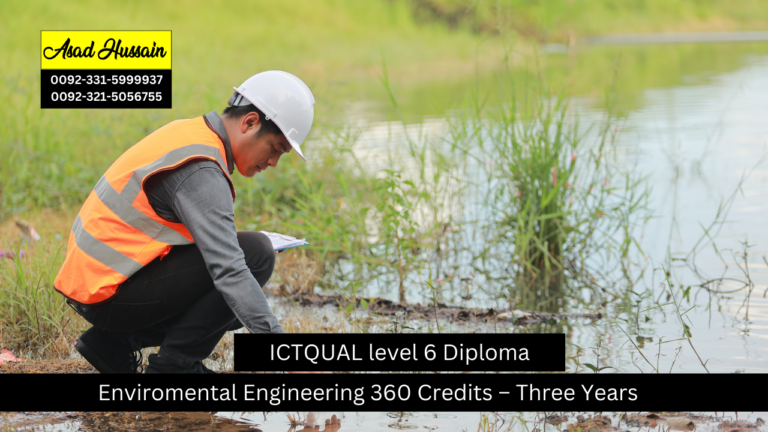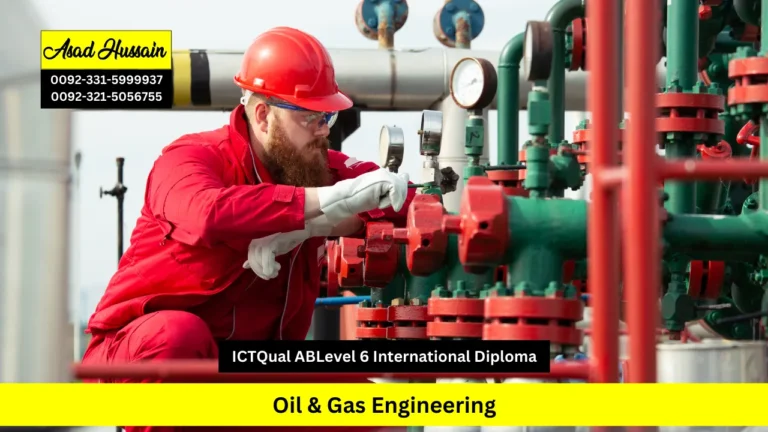The ICTQual AB Diploma in Occupational Health and Safety Engineering (360 Credits – Three Years) is a UK-recognised, comprehensive programme designed to equip learners with advanced knowledge, technical skills, and practical expertise essential for effective workplace safety management. This three-year diploma is ideal for both fresh learners entering the field and experienced professionals seeking formal recognition of their skills and competencies.
ICTQual ABDiploma in Occupational Health and Safety Engineering 360 Credits- Three Years provide learners with a structured pathway to mastery in risk assessment, hazard identification, accident prevention, and emergency planning. The course covers essential aspects of occupational health and safety, including safety audits, regulatory compliance, environmental health, ergonomics, and safety system design. By combining rigorous theoretical study with practical, real-world applications, learners gain the ability to analyse workplace risks, implement safety protocols, and develop strategies that enhance employee wellbeing and operational efficiency.
Throughout the programme, learners build critical professional skills such as safety management, incident investigation, compliance monitoring, and emergency response planning. Practical exercises, projects, and case studies ensure participants can immediately apply their learning to industrial, construction, healthcare, and corporate settings. Graduates of this diploma are fully prepared to take on key roles such as Health and Safety Engineer, Safety Consultant, Risk Manager, or Compliance Officer, while also gaining a strong foundation for higher-level academic progression in safety engineering, risk management, and occupational health studies.
The ICTQual AB Diploma in Occupational Health and Safety Engineering offers a globally recognised qualification that not only enhances professional credibility but also equips learners with the tools to create safer, more compliant, and productive workplaces. By enrolling in this programme, learners position themselves for long-term career growth, leadership opportunities, and a meaningful impact in the field of occupational health and safety.
Program Highlights
This qualification, the ICTQual AB Diploma in Occupational Health and Safety Engineering 360 Credits- Three Years, consists of 36 mandatory units.
Year 1 – Foundation Level
- Introduction to Occupational Health and Safety
- Principles of Risk Assessment and Management
- Workplace Safety Legislation and Compliance
- Fundamentals of Fire Safety Management
- Personal Protective Equipment (PPE) in the Workplace
- Environmental Health and Safety Awareness
- Accident Investigation and Reporting Procedures
- Ergonomics and Human Factors in Safety
- Health and Safety Communication Skills
- Hazard Identification and Control Measures
- Basics of Industrial Hygiene
- Introduction to Emergency Preparedness and Response
Year 2 – Intermediate Level
- Advanced Risk Assessment Techniques
- Fire Safety Systems and Evacuation Planning
- Safety Management Systems (ISO 45001)
- Workplace Safety Auditing and Inspection
- Electrical Safety in the Workplace
- Mechanical and Machinery Safety
- Environmental Protection and Sustainability Practices
- Occupational Health Monitoring and Surveillance
- Safety Leadership and Team Management
- Hazardous Materials and Chemical Safety
- Noise, Vibration, and Occupational Stress Management
- Construction and Industrial Safety Practices
Year 3 – Advanced Level
- Strategic Health and Safety Management
- Advanced Fire Risk Management and Prevention
- Safety Culture Development and Behavioural Safety
- Advanced Accident Investigation and Root Cause Analysis
- Ergonomic Risk Management in Industrial Settings
- Emergency Planning and Crisis Management
- Safety Performance Metrics and KPI Analysis
- Legal Compliance and Occupational Safety Standards
- Environmental Health and Safety Policy Development
- Health and Safety Project Planning and Implementation
- Leadership in Occupational Safety Engineering
- Capstone Project in Occupational Health and Safety Engineering
The ICTQual AB Diploma in Occupational Health and Safety Engineering (360 Credits – Three Years) is designed for individuals aiming to develop advanced expertise in workplace safety, risk management, and regulatory compliance. To ensure learners are fully prepared for the academic and professional demands of this qualification, specific entry requirements are in place to maintain the quality and integrity of the programme.
Age Requirements:
- Applicants must be at least 18 years old at the time of enrolment. There is no strict upper age limit, and candidates of all ages who meet the educational and professional criteria are welcome to apply.
Educational Requirements:
- A minimum of a high school diploma or equivalent is required. Applicants with undergraduate degrees in engineering, environmental science, health and safety, or related fields are particularly well-prepared. Fresh learners from non-safety backgrounds with strong analytical and technical aptitude may also be considered.
Professional Experience:
- While prior experience in occupational health and safety is not mandatory, learners with 3 or more years of relevant work experience may qualify for an accelerated pathway. Experience in risk assessment, safety management, compliance auditing, or industrial safety roles strengthens the learner’s readiness for the programme.
English Language Proficiency:
- Proficiency in English reading, writing, and communication is essential to successfully complete assignments, assessments, and practical exercises. International learners should provide evidence of English proficiency through recognized assessments such as IELTS (minimum score 5.5) or an equivalent qualification.
Meeting these entry requirements ensures that learners are fully prepared to excel in the ICTQual AB Diploma in Occupational Health and Safety Engineering, gaining the knowledge, technical skills, and professional competence needed to implement effective safety systems, manage risks, and advance their careers in occupational health and safety across diverse industries.
The ICTQual AB Diploma in Occupational Health and Safety Engineering (360 Credits – Three Years) is a comprehensive qualification designed to equip learners with the knowledge, skills, and professional competencies needed to create safer and healthier workplaces across diverse industries. This advanced diploma combines theoretical foundations with practical applications, focusing on risk assessment, hazard control, compliance management, emergency preparedness, and safety system optimisation. Learners will gain expertise in workplace legislation, environmental health, accident prevention, and industrial safety practices while also developing leadership and strategic planning capabilities. By completing this programme, graduates will be well-prepared to take on roles in occupational health and safety engineering, risk management, and compliance leadership, or to progress towards higher academic and professional qualifications in the field.
Year 1 – Foundation Level
Introduction to Occupational Health and Safety
Learners will explore the foundations of occupational health and safety engineering, its scope, and importance across industries. Emphasis is placed on understanding how effective safety management contributes to employee wellbeing, workplace productivity, and organizational resilience.
Principles of Risk Assessment and Management
This unit equips learners with the knowledge and skills to identify hazards, evaluate risks, and apply systematic risk management frameworks. Students will learn practical methods to design, implement, and monitor risk control measures effectively.
Workplace Safety Legislation and Compliance
An in-depth understanding of workplace health and safety laws, standards, and regulatory requirements. Learners will study compliance frameworks, employer and employee responsibilities, and international best practices in OHS governance.
Fundamentals of Fire Safety Management
Focuses on principles of fire prevention, detection, and suppression. Learners gain expertise in fire risk assessment, fire safety systems, evacuation planning, and emergency preparedness to minimise workplace fire hazards.
Personal Protective Equipment (PPE) in the Workplace
Explores the role of PPE in hazard control, selection criteria, proper use, maintenance, and compliance with industry standards to ensure maximum protection of workers.
Environmental Health and Safety Awareness
Learners will study environmental factors affecting occupational health, including waste management, pollution control, and sustainability practices that integrate safety with environmental stewardship.
Accident Investigation and Reporting Procedures
Develops the ability to investigate workplace incidents, identify root causes, document findings, and recommend corrective actions. Emphasis is placed on regulatory compliance and continuous improvement.
Ergonomics and Human Factors in Safety
Learners study the science of ergonomics and its role in preventing musculoskeletal disorders, improving workplace design, and enhancing worker comfort, productivity, and safety.
Health and Safety Communication Skills
Focuses on effective communication techniques for promoting health and safety awareness, reporting hazards, and engaging employees in safety programs.
Hazard Identification and Control Measures
Provides learners with knowledge of identifying various workplace hazards and implementing control measures through engineering, administrative, and personal protective strategies.
Basics of Industrial Hygiene
Introduces key concepts of industrial hygiene, including exposure monitoring, ventilation systems, chemical hazard management, and workplace hygiene standards.
Introduction to Emergency Preparedness and Response
Learners study emergency response planning, crisis communication, and contingency frameworks to ensure workplace resilience during unexpected incidents.
Year 2 – Intermediate Level
Advanced Risk Assessment Techniques
Covers detailed methodologies for risk analysis, quantitative assessments, and advanced evaluation of workplace hazards for high-risk industries.
Fire Safety Systems and Evacuation Planning
Learners explore advanced fire protection systems, detection technology, and structured evacuation planning for large-scale industrial and commercial facilities.
Safety Management Systems (ISO 45001)
Focuses on the design, implementation, and auditing of safety management systems aligned with ISO 45001 standards, ensuring organizational compliance and efficiency.
Workplace Safety Auditing and Inspection
Learners gain knowledge of structured safety audits, inspection techniques, compliance evaluation, and reporting procedures for continuous workplace improvement.
Electrical Safety in the Workplace
Emphasises principles of electrical hazard recognition, safe installation practices, grounding, and regulatory compliance for workplace electrical systems.
Mechanical and Machinery Safety
Covers safety aspects of machinery operations, guarding systems, lockout-tagout procedures, and accident prevention in industrial machinery use.
Environmental Protection and Sustainability Practices
Focuses on integrating occupational safety with environmental sustainability, waste minimisation, pollution control, and eco-friendly practices.
Occupational Health Monitoring and Surveillance
Learners gain skills in monitoring employee health, conducting occupational health surveillance programs, and identifying workplace-related illnesses.
Safety Leadership and Team Management
Develops leadership competencies, motivational strategies, and team management skills for driving a proactive safety culture in organizations.
Hazardous Materials and Chemical Safety
Explores safe handling, storage, and disposal of hazardous chemicals, alongside regulatory frameworks for chemical safety compliance.
Noise, Vibration, and Occupational Stress Management
Covers the physical and psychological impacts of noise, vibration, and workplace stress, with strategies to mitigate risks and improve employee wellbeing.
Construction and Industrial Safety Practices
Focuses on safety management within construction and heavy industries, including scaffolding safety, excavation hazards, and project-based risk assessments.
Year 3 – Advanced Level
Strategic Health and Safety Management
Learners study strategic planning for safety programs, organizational policy alignment, and integration of safety objectives with corporate strategies.
Advanced Fire Risk Management and Prevention
Explores advanced fire dynamics, risk modeling, suppression techniques, and fire safety integration within high-risk industrial environments.
Safety Culture Development and Behavioural Safety
Focuses on cultivating positive safety behaviours, employee engagement, and culture-building to achieve long-term safety excellence.
Advanced Accident Investigation and Root Cause Analysis
Develops advanced skills in investigating complex accidents, applying root cause analysis techniques, and implementing preventative strategies.
Ergonomic Risk Management in Industrial Settings
Learners apply ergonomic principles to complex industrial environments, focusing on high-risk tasks, automation impacts, and ergonomic design.
Emergency Planning and Crisis Management
Provides advanced knowledge of organizational crisis planning, emergency response teams, business continuity strategies, and disaster recovery.
Safety Performance Metrics and KPI Analysis
Learners will understand the importance of performance measurement through KPIs, benchmarking, and reporting for continuous safety improvement.
Legal Compliance and Occupational Safety Standards
In-depth analysis of international safety standards, legal frameworks, and compliance auditing across global industries.
Environmental Health and Safety Policy Development
Learners will design, evaluate, and implement EHS policies that align with organizational goals, regulations, and sustainability principles.
Health and Safety Project Planning and Implementation
Focuses on project management skills specific to occupational safety initiatives, from planning to execution and performance evaluation.
Leadership in Occupational Safety Engineering
Develops high-level leadership skills to influence organizational safety strategies, motivate teams, and drive innovation in OHS engineering.
Capstone Project in Occupational Health and Safety Engineering
A comprehensive final project requiring learners to apply accumulated knowledge and skills to solve real-world occupational health and safety challenges.
The ICTQual AB Diploma in Occupational Health and Safety Engineering (360 Credits – Three Years) is designed for individuals who are passionate about workplace safety, risk management, and creating compliant and efficient organisational environments. Learners who take this course are typically safety professionals, engineers, managers, and aspiring OHS leaders seeking to enhance their careers in occupational health and safety, compliance, and risk management.
Safety Engineers and OHS Coordinators:
Professionals responsible for implementing, monitoring, and managing occupational health and safety systems.
Individuals aiming to strengthen their skills in risk assessment, hazard control, emergency planning, and compliance management.
Health and Safety Practitioners and Administrators:
Engineers, safety officers, industrial hygienists, or workplace managers who want to expand their expertise into comprehensive OHS engineering roles.
Practitioners seeking to apply structured health and safety frameworks to improve workplace safety, reduce risks, and ensure regulatory compliance.
Supervisors and Team Leaders:
Leaders overseeing departments, operations, or projects who want to enhance their skills in safety management, team coordination, and risk monitoring.
Team leaders aiming to develop advanced capabilities in hazard assessment, safety leadership, and compliance evaluation to achieve organisational safety objectives.
Career-Focused Learners:
Individuals pursuing career progression in occupational health and safety, risk management, compliance auditing, or safety engineering.
Learners seeking to qualify for senior roles where expertise in workplace safety, regulatory compliance, and risk control is highly valued.
This course is ideal for learners committed to achieving professional excellence in occupational health and safety. It provides a strong foundation for those aspiring to make a significant impact in workplace safety, risk management, and compliance across industrial, corporate, and public-sector environments, preparing them for leadership roles locally and internationally.
The ICTQual AB Diploma in Occupational Health and Safety Engineering (360 Credits – Three Years) is a UK-recognised, comprehensive programme designed to equip learners with advanced knowledge, practical skills, and professional expertise in workplace safety, risk management, and regulatory compliance. This diploma provides a structured learning pathway for both fresh learners and experienced professionals, covering essential topics such as hazard identification, risk assessment, emergency planning, fire safety, ergonomics, and compliance with international safety standards. By combining theoretical study with practical, real-world applications, the programme prepares graduates to implement effective occupational health and safety systems, ensure regulatory compliance, and contribute to safer, more productive workplaces across industrial, corporate, and public-sector environments.
Route for Candidates with No Experience
This pathway is specifically designed for individuals who are new to occupational health and safety engineering and do not have prior work experience.
- Admission: Learners must enrol at an ICTQual Approved Training Centre, where they will complete formal training covering all essential study units. This includes occupational safety principles, risk assessment, fire safety, ergonomics, emergency planning, environmental health, and compliance with international safety standards.
- Assessment: Learners are evaluated through assignments, practical projects, and hands-on assessments that demonstrate understanding of key occupational safety concepts and engineering practices. Competency is measured in areas such as risk control, accident investigation, safety communication, and emergency preparedness.
- Certification: Upon successful completion of all training modules and assessments, learners are awarded the ICTQual AB Diploma in Occupational Health and Safety Engineering (360 Credits), fully preparing them for professional roles in industrial, corporate, and public-sector environments.
Route for Experienced and Competent Candidates
This pathway is tailored for professionals with relevant work experience in occupational health and safety engineering who wish to formalise their expertise.
- Eligibility: Applicants must demonstrate at least three years of verified professional experience in OHS roles. Key skills include risk assessment, workplace safety management, accident investigation, and compliance with safety regulations.
- Assessment: Competence is assessed at an ICTQual Approved Training Centre, with knowledge and skills evaluated against the course’s learning outcomes. Full formal training may not be required if prior experience meets programme standards.
- Evidence Submission: Learners provide detailed documentation of their work experience, including roles, responsibilities, projects, and safety initiatives led. Verification may include references, workplace reports, safety audits, emergency response records, and risk management activities.
- Certification: Upon successful verification of competence, learners are awarded the ICTQual AB Diploma in Occupational Health and Safety Engineering (360 Credits), recognising both their prior experience and professional capabilities.
Both certification routes ensure that learners acquire comprehensive occupational health and safety knowledge, practical skills, and professional expertise. Whether entering the field for the first time or advancing from previous professional experience, graduates are fully prepared for a successful career in workplace safety, risk management, and compliance.







